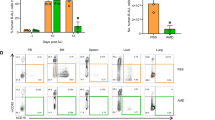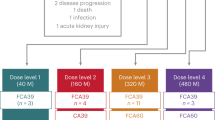Abstract
The use of thiotepa (TH) is increasing, especially in stem cell transplantation, mainly due to its safety and blood–brain barrier penetration. We evaluated the use of TH in a murine model simulating autologous stem cell transplantation, with or without additional agents. Between 1 and 11 days following inoculation of BALB/c mice with 105–108 B-cell leukemia (BCL1) cells (simulating pre-transplant leukemia loads), each group received an ‘induction-like’ irradiation and/or cytotoxic regimen. Animals were either followed without treatment, or an adoptive transfer (AT) was performed to untreated BALB/c mice. Administered alone without AT, high-dose TH did not change the time to appearance of leukemia. Nevertheless, in the AT experiments, TH as a single agent showed better antileukemic activity than busulfan (BU). Cyclophosphamide (CY)-containing regimens were the most effective, and the TH–CY combination was as effective as the commonly used BU–CY combination, and more effective than the BU–TH combination. Moreover, a synergistic effect was seen in the TH–CY combination (none of the animals developed leukemia, whereas 4/10 animals in the CY–TBI group developed leukemia (P=0.029)). In conclusion, although TH produced only a moderate effect against BCL1 leukemia when used alone, its combination with CY is promising and should be tested further in allogeneic murine models and clinical studies.
This is a preview of subscription content, access via your institution
Access options
Subscribe to this journal
Receive 12 print issues and online access
$259.00 per year
only $21.58 per issue
Buy this article
- Purchase on Springer Link
- Instant access to full article PDF
Prices may be subject to local taxes which are calculated during checkout






Similar content being viewed by others
References
Shay H, Zarafonetis C, Smith N, Wolodow I, Sun DC . Treatment of leukemia with triethylene thiophosphoramide (thio-TEPA); preliminary results in experimental and clinical leukemia. Arch Intern Med 1953; 92: 628–645.
Ghalie R, Richman CM, Adler SS, Cobleigh MA, Korenblit AD, Manson SD et al. Treatment of metastatic breast cancer with a split-course high-dose chemotherapy regimen and autologous bone marrow transplantation. J Clin Oncol 1994; 12: 342–346.
Horn Y, Eidelman A, Walach N, Yuval E, Markowitz A . Treatment of superficial bladder tumors in a controlled trial with thio-tepa versus adriamycin. J Surg Oncol 1984; 27: 67–69.
Koontz Jr WW, Prout Jr GR, Smith W, Frable WJ, Minnis JE . The use of intravesical thio-tepa in the management of non-invasive carcinoma of the bladder. J Urol 1981; 125: 307–312.
Damon L, Wolf I, Rugo H . Autologous bone marrow transplant for non-Hodgkin's and Hodgkin's lymphoma using a thiotepa-based preparative regimen. Blood 1994; 84 (Suppl 1): 706a.
Dimopoulos MA, Alexanian R, Przepiorka D, Hester J, Andersson B, Giralt S et al. Thiotepa, busulfan, and cyclophosphamide: a new preparative regimen for autologous marrow or blood stem cell transplantation in high-risk multiple myeloma. Blood 1993; 82: 2324–2328.
Bergh J, Wiklund T, Erikstein B, Lidbrink E, Lindman H, Malmstrom P et al. Tailored fluorouracil, epirubicin, and cyclophosphamide compared with marrow-supported high-dose chemotherapy as adjuvant treatment for high-risk breast cancer: a randomised trial. Scandinavian Breast Group 9401 study. Lancet 2000; 356: 1384–1391.
Bacigalupo A, Van Lint M, Valbonesi M, Lercari G, Carlier P, Lamparelli T et al. Thiotepa cyclophosphamide followed by granulocyte colony-stimulating factor mobilized allogeneic peripheral blood cells in adults with advanced leukemia. Blood 1996; 88: 353–357.
Bitran JD, Williams SF, Moormeier J, Mick R . High-dose combination chemotherapy with thiotepa and autologous hematopoietic stem cell reinfusion in the treatment of patients with relapsed refractory lymphomas. Semin Oncol 1990; 17: 39–42.
Slavin S, Strober S . Spontaneous murine B-cell leukemia. Nature 1978; 272: 624–626.
Slavin S, Weiss L, Morecki S, Bassat HB, Leizerowitz R, Gamliel H et al. Ultrastructural, cell membrane and cytogenetic characteristics of B-cell leukemia (BCL1), a murine model of chronic lymphocytic leukemia. Cancer Res 1981; 41: 4162–4166.
Buckner CD, Clift RA, Fefer A, Neiman PE, Storb R, Thomas ED . Treatment of blastic transformation of chronic granulocytic leukemia by high dose cyclophosphamide, total body irradiation and infusion of cryopreserved autologous marrow. Exp Hematol 1974; 2: 138–146.
Copelan EA, Tutschka PJ . Marrow transplantation following busulfan and cyclophosphamide in multiple myeloma. Bone Marrow Transplant 1988; 3: 363–365.
Kirmani S, McVey L, Loo D, Howell SB . A phase I clinical trial of intraperitoneal thiotepa for refractory ovarian cancer. Gynecol Oncol 1990; 36: 331–334.
Locatelli F, Giorgiani G, Pession A, Bozzola M . Late effects in children after bone marrow transplantation: a review. Haematologica 1993; 78: 319–328.
Hartman AR, Williams SF, Dillon JJ . Survival, disease-free survival and adverse effects of conditioning for allogeneic bone marrow transplantation with busulfan/cyclophosphamide vs total body irradiation: a meta-analysis. Bone Marrow Transplant 1998; 22: 439–443.
Dai QY, Souillet G, Bertrand Y, Galambrun C, Bleyzac N, Manel AM et al. Antileukemic and long-term effects of two regimens with or without TBI in allogeneic bone marrow transplantation for childhood acute lymphoblastic leukemia. Bone Marrow Transplant 2004; 34: 667–673.
Acknowledgements
Dr Shapira's work is supported by the Dr Sima Lior fund.
Author information
Authors and Affiliations
Corresponding author
Rights and permissions
About this article
Cite this article
Abdul-Hai, A., Weiss, L., Ergas, D. et al. The effect of high-dose thiotepa, alone or in combination with other chemotherapeutic agents, on a murine B-cell leukemia model simulating autologous stem cell transplantation. Bone Marrow Transplant 40, 891–896 (2007). https://doi.org/10.1038/sj.bmt.1705838
Received:
Revised:
Accepted:
Published:
Issue Date:
DOI: https://doi.org/10.1038/sj.bmt.1705838
Keywords
This article is cited by
-
Primary central nervous system lymphoma: implication of high-dose chemotherapy followed by auto-SCT
Bone Marrow Transplantation (2012)



